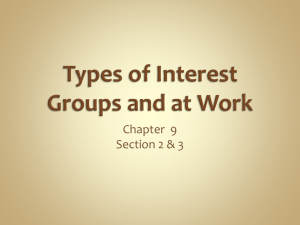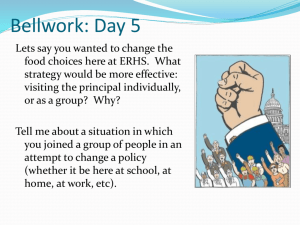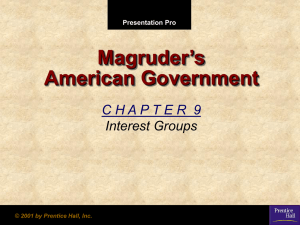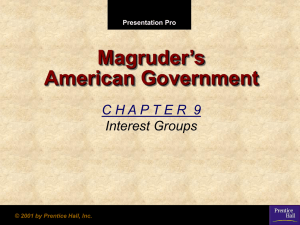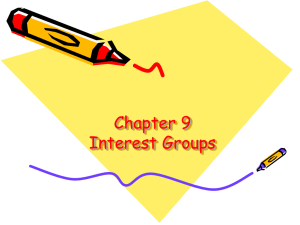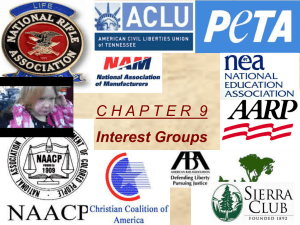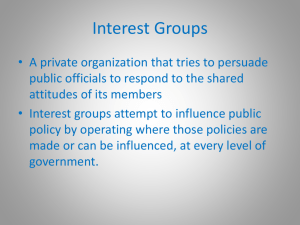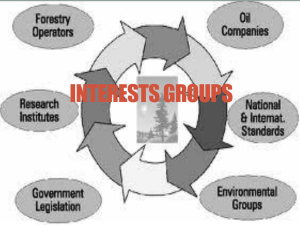Economics: Principles in Action
advertisement
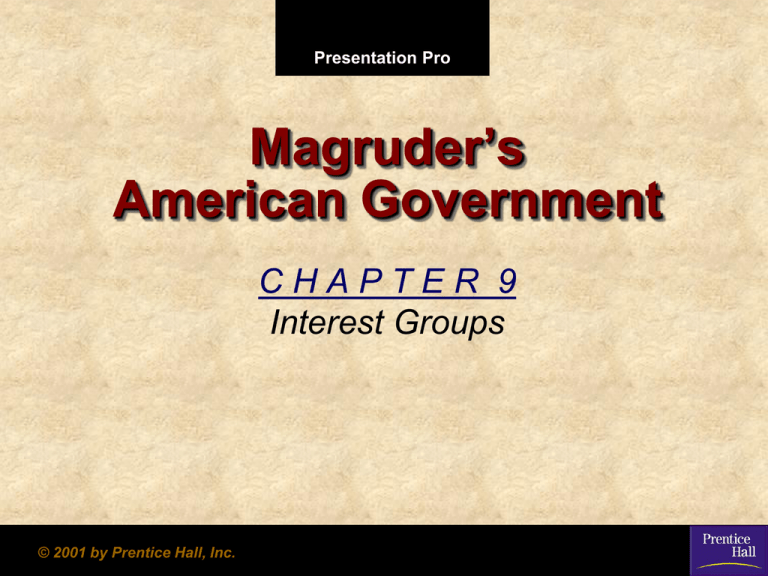
Presentation Pro Magruder’s American Government CHAPTER 9 Interest Groups © 2001 by Prentice Hall, Inc. CHAPTER 9 Interest Groups SECTION 1 The Nature of Interest Groups SECTION 2 Types of Interest Groups SECTION 3 Interest Groups at Work Go To Section: 1 2 3 Chapter 9 Warm up: Word Association • How do these two terms relate? Interest Group Public Policy Go To Section: 1 2 3 SECTION 1 The Nature of Interest Groups • What role do interest groups have in influencing public policy? • How can we compare and contrast political parties and interest groups? • Why do people see interest groups as both good and bad for American politics? Go To Section: 1 2 3 Chapter 9, Section 1 The Role of Interest Groups • Interest groups are private organizations whose members share certain views and work to shape public policy. • Public policy includes all of the goals a government sets and the various courses of action it pursues as it attempts to realize these goals. • Interest groups exist to shape public policy. Cram for the Exam Americans for Prosperity Go To Section: 1 2 3 Koch Industries Chapter 9, Section 1 Political Parties and Interest Groups Explain this quote: “Political parties are mostly interested in the who and interest groups are mostly interested in the what of government.” Go To Section: 1 2 3 Chapter 9, Section 1 Political Parties and Interest Groups Political parties and interest groups differ in three striking respects: (1) in the making of nominations, (2) in their primary focus, and (3) in the scope of their interests. Nominations • Political parties are responsible for the nominating process, while interest groups hope to influence those nominations. Primary Focus • Political parties are interested in winning elections and controlling government, while interest groups are interested in influencing the policies created by government. Scope of Interest • Political parties concern themselves with the whole range of public affairs, while interest groups tend to focus on issues that their members are concerned about. Go To Section: 1 2 3 Chapter 9, Section 1 Interest Groups: Good or Bad? • Read James Madison Quote on p. 238 What was Madison’s opinion of interest groups? Good or Bad? Why? Can they be eliminated? Congress shall make no law respecting an establishment of religion, or prohibiting the free exercise thereof; or abridging the freedom of speech, or of the press; or the right of the people peaceably to assemble, and to petition the Government for a redress of grievances. Go To Section: 1 2 3 Interest Groups: Good or Bad? • • Do Americans take advantage of the 1st amendment right of association? Read the Quotes on p. 239 from Alexis de Tocqueville • Go To Section: List of American Interest Groups 1 2 3 Valuable Functions of Interest Groups Read “Valuable functions of Interest Groups (p.239). Explain each of the following functions. 1. Interest groups raise awareness of public affairs 2. Interest groups represent people who share attitudes/values rather than those who share geography. 3. Are a source of information. 4. Interest groups are vehicles for political participation. 5. Interest groups keep tabs on various public agencies and officials. 6. Interest groups compete and balance one another Go To Section: 1 2 3 Chapter 9, Section 1 Criticisms • Some groups have an influence far out of proportion to their size or importance. • It can be difficult to tell who or how many people are served by a group. • Groups do not always represent the views of the people they claim to speak for. • In rare cases, groups use tactics such as bribery, threats, and so on. • Money plays an increasing role – unlimited campaign activities. Go To Section: 1 2 3 Chapter 9, Section 1 Chicken Poop?? What different interest groups might be involved in this example? For Friday: Read Chapter 9, Section 1, and complete the Guided Reading Worksheet Go To Section: 1 2 3 Chapter 9, Section 1 SECTION 2 Types of Interest Groups • How has the American tradition of joining organizations resulted in a wide range of interest groups? • What are the four categories of groups based on economic interests? • What are the reasons other interest groups have formed? • What is the purpose of public-interest groups? Go To Section: 1 2 3 Chapter 9, Section 2 Reasons for Interest Groups • • • • • Most interest groups have been founded on the basis of an economic interest, especially business, labor, agricultural, and professional interests. Some are grounded in geographic area. Some are based on a cause or idea, such as environmental protection. Some promote the welfare of certain groups of people, such as retired citizens. Some are run by religious organizations. Go To Section: 1 2 3 Chapter 9, Section 2 Membership in Labor Unions Go To Section: 1 2 3 Chapter 9, Section 2 Public-Interest Groups A public-interest group is an interest group that seeks to institute certain public policies that will benefit all or most of the people in the country, whether or not they belong to that organization. Go To Section: 1 2 3 Chapter 9, Section 2 Section 2 Review • • • • • • At what point does an organization become an interest group? What are the four major types of economically based interest groups? List an example of each type. How does a trade association differ from a labor union? What do you think explains the decline of labor unions? Cite an example of a public interest group and explain how it differs from private interest groups. Visit the website of one specific interest group in each of the categories listed below. For each interest group identify one specific public policy issue the group is pursuing for its members. Business group Labor group Agricultural group Professional group Go To Section: 1 2 3 Chapter 9, Section 2 SECTION 3 Interest Groups at Work • What are interest groups’ three major goals in influencing public opinion? • How do interest groups use propaganda to persuade people to their point of view? • How do interest groups try to influence political parties and elections? • How does lobbying bring group pressures to bear on the process of making public policy? Go To Section: 1 2 3 Chapter 9, Section 3 Lobbyists at work Lobbyists Playbook Behind Closed Doors •Warm Up – Section 3 reading quiz •Complete the quiz – Flip it over when your done Go To Section: 1 2 3 Influencing Public Opinion Interest groups reach out to the public for these reasons: 1. To supply information in support of the group’s interests Brady Campaign 2. To build a positive image for the group NRA 3. To promote a particular public policy Background Checks Go To Section: 1 2 3 Chapter 9, Section 3 Propaganda • Propaganda is a technique of persuasion aimed at influencing individual or group behaviors. • Its goal is to create a particular belief which may be true or false. TEA • Propaganda disregards information that does not support its conclusion. It is not objective. It presents only one side of an issue. • Propaganda often relies on name-calling and inflammatory labels and/or positive or negative symbols. Health Care Go To Section: 1 2 3 Chapter 9, Section 3 Go To Section: 1 2 3 Influencing Parties and Elections • Political Action Committees (PACs) raise and distribute money to candidates who will further their goals. PACS Go To Section: 1 2 3 Chapter 9, Section 3 Lobbying • Lobbying is any activity by which a group pressures legislators and influences the legislative process. Grass Roots • Lobbying carries beyond the legislature. It is brought into government agencies, the executive branch, and even the courts. NRA • Nearly all important organized interest groups maintain lobbyists in Washington, D.C. Lobbying Groups Go To Section: 1 2 3 Chapter 9, Section 3 Lobbyists at Work Lobbyists use several techniques: • They send articles, reports, and other information to officeholders. • They testify before legislative committees. • They bring “grass-roots” pressures to bear through email, letters, or phone calls from constituents. • They rate candidates and publicize the ratings. NRA GOAL • They make campaign contributions. 2012 election Go To Chapter 9, Section 3 OftenSection: to both party and sector 1 parties…By 2 3 Homework For Thursday • Read Ch. 9, section 3 with Guided Reading WS Go To Section: 1 2 3 Chapter 9, Section 3
